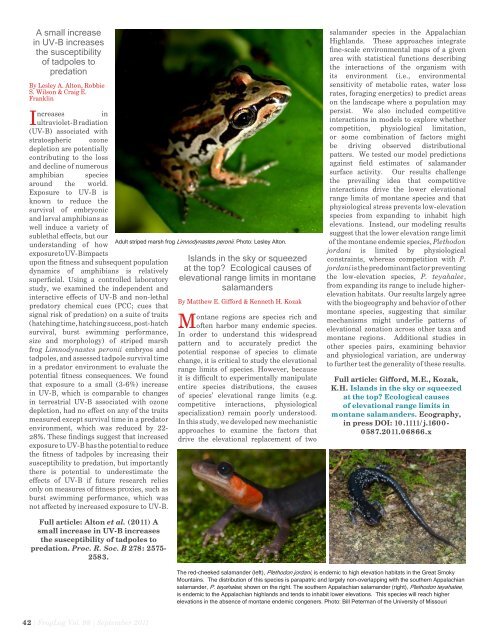download the PDF here - Amphibian Specialist Group
download the PDF here - Amphibian Specialist Group
download the PDF here - Amphibian Specialist Group
You also want an ePaper? Increase the reach of your titles
YUMPU automatically turns print PDFs into web optimized ePapers that Google loves.
A small increase<br />
in UV-B increases<br />
<strong>the</strong> susceptibility<br />
of tadpoles to<br />
predation<br />
By Lesley A. Alton, Robbie<br />
S. Wilson & Craig E.<br />
Franklin<br />
Increases<br />
in<br />
ultraviolet-B radiation<br />
(UV-B) associated with<br />
stratospheric ozone<br />
depletion are potentially<br />
contributing to <strong>the</strong> loss<br />
and decline of numerous<br />
amphibian species<br />
around <strong>the</strong> world.<br />
Exposure to UV-B is<br />
known to reduce <strong>the</strong><br />
survival of embryonic<br />
and larval amphibians as<br />
well induce a variety of<br />
sublethal effects, but our<br />
understanding of how<br />
exposure to UV-B impacts<br />
upon <strong>the</strong> fitness and subsequent population<br />
dynamics of amphibians is relatively<br />
superficial. Using a controlled laboratory<br />
study, we examined <strong>the</strong> independent and<br />
interactive effects of UV-B and non-lethal<br />
predatory chemical cues (PCC; cues that<br />
signal risk of predation) on a suite of traits<br />
(hatching time, hatching success, post-hatch<br />
survival, burst swimming performance,<br />
size and morphology) of striped marsh<br />
frog Limnodynastes peronii embryos and<br />
tadpoles, and assessed tadpole survival time<br />
in a predator environment to evaluate <strong>the</strong><br />
potential fitness consequences. We found<br />
that exposure to a small (3-6%) increase<br />
in UV-B, which is comparable to changes<br />
in terrestrial UV-B associated with ozone<br />
depletion, had no effect on any of <strong>the</strong> traits<br />
measured except survival time in a predator<br />
environment, which was reduced by 22-<br />
28%. These findings suggest that increased<br />
exposure to UV-B has <strong>the</strong> potential to reduce<br />
<strong>the</strong> fitness of tadpoles by increasing <strong>the</strong>ir<br />
susceptibility to predation, but importantly<br />
<strong>the</strong>re is potential to underestimate <strong>the</strong><br />
effects of UV-B if future research relies<br />
only on measures of fitness proxies, such as<br />
burst swimming performance, which was<br />
not affected by increased exposure to UV-B.<br />
Adult striped marsh frog Limnodynastes peronii. Photo: Lesley Alton.<br />
Islands in <strong>the</strong> sky or squeezed<br />
at <strong>the</strong> top? Ecological causes of<br />
elevational range limits in montane<br />
salamanders<br />
By Mat<strong>the</strong>w E. Gifford & Kenneth H. Kozak<br />
Montane regions are species rich and<br />
often harbor many endemic species.<br />
In order to understand this widespread<br />
pattern and to accurately predict <strong>the</strong><br />
potential response of species to climate<br />
change, it is critical to study <strong>the</strong> elevational<br />
range limits of species. However, because<br />
it is difficult to experimentally manipulate<br />
entire species distributions, <strong>the</strong> causes<br />
of species’ elevational range limits (e.g.<br />
competitive interactions, physiological<br />
specialization) remain poorly understood.<br />
In this study, we developed new mechanistic<br />
approaches to examine <strong>the</strong> factors that<br />
drive <strong>the</strong> elevational replacement of two<br />
salamander species in <strong>the</strong> Appalachian<br />
Highlands. These approaches integrate<br />
fine-scale environmental maps of a given<br />
area with statistical functions describing<br />
<strong>the</strong> interactions of <strong>the</strong> organism with<br />
its environment (i.e., environmental<br />
sensitivity of metabolic rates, water loss<br />
rates, foraging energetics) to predict areas<br />
on <strong>the</strong> landscape w<strong>here</strong> a population may<br />
persist. We also included competitive<br />
interactions in models to explore whe<strong>the</strong>r<br />
competition, physiological limitation,<br />
or some combination of factors might<br />
be driving observed distributional<br />
patters. We tested our model predictions<br />
against field estimates of salamander<br />
surface activity. Our results challenge<br />
<strong>the</strong> prevailing idea that competitive<br />
interactions drive <strong>the</strong> lower elevational<br />
range limits of montane species and that<br />
physiological stress prevents low-elevation<br />
species from expanding to inhabit high<br />
elevations. Instead, our modeling results<br />
suggest that <strong>the</strong> lower elevation range limit<br />
of <strong>the</strong> montane endemic species, Plethodon<br />
jordani is limited by physiological<br />
constraints, w<strong>here</strong>as competition with P.<br />
jordani is <strong>the</strong> predominant factor preventing<br />
<strong>the</strong> low-elevation species, P. teyahalee,<br />
from expanding its range to include hig<strong>here</strong>levation<br />
habitats. Our results largely agree<br />
with <strong>the</strong> biogeography and behavior of o<strong>the</strong>r<br />
montane species, suggesting that similar<br />
mechanisms might underlie patterns of<br />
elevational zonation across o<strong>the</strong>r taxa and<br />
montane regions. Additional studies in<br />
o<strong>the</strong>r species pairs, examining behavior<br />
and physiological variation, are underway<br />
to fur<strong>the</strong>r test <strong>the</strong> generality of <strong>the</strong>se results.<br />
Full article: Gifford, M.E., Kozak,<br />
K.H. Islands in <strong>the</strong> sky or squeezed<br />
at <strong>the</strong> top? Ecological causes<br />
of elevational range limits in<br />
montane salamanders. Ecography,<br />
in press DOI: 10.1111/j.1600-<br />
0587.2011.06866.x<br />
Full article: Alton et al. (2011) A<br />
small increase in UV-B increases<br />
<strong>the</strong> susceptibility of tadpoles to<br />
predation. Proc. R. Soc. B 278: 2575-<br />
2583.<br />
The red-cheeked salamander (left), Plethodon jordani, is endemic to high elevation habitats in <strong>the</strong> Great Smoky<br />
Mountains. The distribution of this species is parapatric and largely non-overlapping with <strong>the</strong> sou<strong>the</strong>rn Appalachian<br />
salamander, P. teyahalee, shown on <strong>the</strong> right. The sou<strong>the</strong>rn Appalachian salamander (right), Plethodon teyahalee,<br />
is endemic to <strong>the</strong> Appalachian highlands and tends to inhabit lower elevations. This species will reach higher<br />
elevations in <strong>the</strong> absence of montane endemic congeners. Photo: Bill Peterman of <strong>the</strong> University of Missouri<br />
42 | FrogLog Vol. 98 | September 2011
















